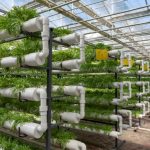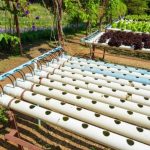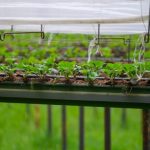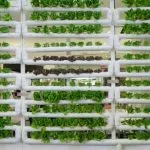As hydroponics continues to gain popularity among urban farmers and gardening enthusiasts, it’s essential to understand the different systems available and how to manage each. One such system is the Nutrient Film Technique (NFT) hydroponics. Properly managing your NFT watering schedule can make all the difference in the health and productivity of your plants. In this blog post, we will explore tips and techniques on how to create an optimal NFT hydroponics watering schedule that promotes healthy plant growth and maximizes yield.

Before diving into the watering schedule, let’s get a basic understanding of what an NFT hydroponic system entails. In this setup, a thin film of nutrient-rich water continuously flows over plant roots as they grow in channels or troughs. The root tips remain submerged in the solution while most parts are exposed to air. This allows plants to respire effectively and encourages robust growth. Go more in-depth with our guide on how does the nutrient film technique system work.
The Importance of an Efficient Watering Schedule
An effective watering schedule is crucial in any hydroponic system, but even more so in NFT setups due to their continuous flow design. By providing a steady supply of water and nutrients directly onto the root zone, you ensure that plants have everything they need for proper growth at all times. A well-maintained watering schedule prevents issues like nutrient lockout or overwatering while promoting faster growth rates, healthier foliage, and increased yields.
Assess Environmental Factors
The first step towards building an efficient NFT hydroponics watering schedule is understanding how environmental factors impact your plants’ needs. Temperature, humidity levels, and light exposure can significantly influence water requirements; therefore, closely monitor these factors in your grow space to make informed decisions on scheduling.
Temperature
Higher temperatures can lead to increased evaporation, causing plants to consume more water. Monitor your grow area’s ambient temperature and adjust the watering schedule accordingly. If it is too hot, consider increasing the flow rate or implementing a cooling system.
Humidity
Humidity plays an essential role in water consumption. In low humidity environments, plants may require more frequent watering as they lose moisture through transpiration. Conversely, high humidity conditions may call for a less frequent schedule due to reduced evaporation rates.
Light Exposure
Increased light exposure typically equates to faster plant growth and consequently higher water and nutrient demands. As you adjust the lighting setup or duration within your grow space, be prepared to fine-tune your watering schedule as well.
Determine Watering Frequency & Duration
Once environmental factors are considered, you need to establish how often and for how long the NFT system should run each day. This greatly depends on the type of crop being grown and its respective growth stage. Most growers opt for a ratio of 1 minute on and 5-10 mins off.
Seedlings & Early Growth Stages
Young seedlings and plants in early growth stages generally require less water than fully established crops. During this period, start with a lower flow rate or shorter duration (e.g., 15 minutes every hour) and gradually increase as the plants mature. You can lower the frequency for the nighttime to compensate for lower temperatures.
Mature Plants & Flowering Stages
As plants enter their mature and flowering stages, their demand for water increases significantly. Adjust your NFT water flow rate by increasing both frequency (every 30-45 minutes) and duration (20-30 minutes per cycle) during the day to ensure that they receive enough nutrients and reduce it a bit during the night to prevent the roots from becoming overwatered.
Monitoring & Fine-Tuning Your Watering Schedule
The key to a successful NFT hydroponics watering schedule is constant monitoring and adjustment based on plant response. Keep an eye out for signs of overwatering (yellow leaves, wilting, and root rot) or underwatering (dry, curled leaves). If you notice any of these symptoms, adjust your schedule accordingly until the issue is resolved.
Related: You can also check out our guides on a drip system hydroponic watering cycle and a flood and drain watering cycle.
What is an Ideal NFT Flow Rate?
An ideal NFT channel flow rate refers to the optimal speed at which nutrient-rich water moves through the channels of your hydroponic system. This flow rate ensures that plants receive adequate nutrients and oxygen without causing waterlogging or nutrient deficiency. The ideal flow rate varies depending on factors such as plant type, growth stage, and environmental conditions.
Generally, a flow rate of 1-2 liters per minute (LPM) for each channel is considered effective for most plants. That’s 1/4 gallon to 1/2 gallon per minute. However, it’s essential to monitor your plants’ health and adjust the flow rate accordingly to achieve optimal growth and yield in your specific setup.
What is a Good NFT Slope Angle?
A good NFT (Nutrient Film Technique) slope angle is crucial for ensuring proper water flow and nutrient distribution throughout the hydroponic system. When studying how to build a NFT hydroponic system, the ideal slope angle will provide enough incline to allow the nutrient solution to flow smoothly without causing pooling or stagnant water, which can lead to root rot or other issues.
Generally, a slope angle between 1-3% (0.6-1.7 degrees) is considered effective for most NFT systems. One inch of drop for every 30 inches of length is the sweet spot. The maximum allowed ratio is 1 inch for every 40 inches. This slight incline enables gravity to assist in moving the nutrient-rich water along the channels while still providing an even distribution of nutrients and oxygen to all plants within the system.
The angle of the slope may be changed as the plants develop to speed up or slow down the drainage. It’s essential to monitor your plants’ health and make adjustments as needed to ensure optimal growth conditions in your particular setup.
FAQs
Conclusion
A well-maintained NFT hydroponics watering schedule can make a world of difference in your plants’ growth and overall health. By considering environmental factors, plant stages, and continuously monitoring and adjusting the schedule as needed, you can ensure that your hydroponic system runs smoothly and provides an optimal environment for your plants to thrive.







